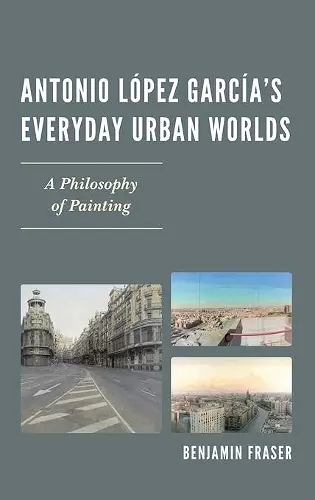Antonio López García’s Everyday Urban Worlds
A Philosophy of Painting
Format:Hardback
Publisher:Associated University Presses
Published:26th Aug '14
Currently unavailable, and unfortunately no date known when it will be back

Antonio López García’s Everyday Urban Worlds: A Philosophy of Painting is the first book to give the famed Spanish artist the critical attention he deserves. Born in Tomelloso in 1936 and still living in the Spanish capital today, Antonio López has long cultivated a reputation for impressive urban scenes—but it is urban time that is his real subject.
Going far beyond mere artist biography, Benjamin Fraser explores the relevance of multiple disciplines to an understanding of the painter’s large-scale canvasses. Weaving selected images together with their urban referents—and without ever straying too far from discussion of the painter’s oeuvre, method and reception by critics—Fraser pulls from disciplines as varied as philosophy, history, Spanish literature and film, cultural studies, urban geography, architecture, and city planning in his analyses.
The book begins at ground level with one of the artist’s most recognizable images, the Gran Vía, which captures the urban project that sought to establish Madrid as an emblem of modernity. Here, discussion of the artist’s chosen painting style—one that has been referred to as a ‘hyperrealism’—is integrated with the central street’s history, the capital’s famous literary figures, and its filmic representations, setting up the philosophical perspective toward which the book gradually develops.
Chapter two rises in altitude to focus on Madrid desde Torres Blancas, an urban image painted from the vantage point provided by an iconic high-rise in the north-central area of the city. Discussion of the Spanish capital’s northward expansion complements a broad view of the artist’s push into representations of landscape and allows for the exploration of themes such as political conflict, social inequality, and the accelerated cultural change of an increasingly mobile nation during the 1960s.
Chapter three views Madrid desde la torre de bomberos de Vallecas and signals a turn toward political philosophy. Here, the size of the artist’s image itself foregrounds questions of scale, which Fraser paints in broad strokes as he blends discussions of artistry with the turbulent history of one of Madrid’s outlying districts and a continued focus on urban development and its literary and filmic resonance.
Antonio López García’s Everyday Urban Worlds also includes an artist timeline, a concise introduction and an epilogue centering on the artist’s role in the Spanish film El sol del membrillo. The book’s...
For decades, Antonio López García has defamiliarized Madrid in his paintings, and in Antonio López García ´s Everyday Urban Worlds: A Philosophy of Painting, Benjamin Fraser defamiliarizes López ´s paintings. He looks, thinks, feels, and walks us through the artist’s seen-and-unseen Madrid in a journey that is in equal parts realistic and oneiric, and he does so with telling accuracy. López is eminently a painter of place, and Fraser takes us in and out of the frames in a constant movement between the canvas and its social surroundings. But he also shows us that López is just as eminently a painter of time, and he guides us to Madrid’s past and its historical and artistic links to the present. The result is an important contribution to the study of contemporary Madrid and its culture. -- Edward Baker, author of Madrid Cosmopolita: La Gran Vía 1910-1936 and Materiales para escribir Madrid
Antonio López García’s Everyday Urban Worlds confirms Fraser’s growing reputation as the leading practitioner of cultural geography in the field of Hispanic studies. His look at three key López paintings begins as a critical stroll through a half century of life and literature in Spain’s capital city but quickly morphs into an often breathtaking tour de force analysis of cultural artifacts, historical detail, and spatial theory wherein the processes of the very urbanization of consciousness are laid bare. At the same time, by highlighting the dialogue of these paintings with not merely the city as object but with the rich complexity of urbanization as process, Fraser breathes new life into the López oeuvre, gifting the artist the critical attention he clearly merits. -- Nathan Richardson, associate professor of Spanish and chair of the Department of Romance and Classical Studies, Bowling Green State University
Taking his cue from López García, a self-described tireless city stroller, Fraser expertly moves through vast expanses of urban time and space to peel back the layers of each locale’s discursive palimpsest, integrating commentary of well-known representations of Madrid created by the capital city’s most attentive observers (like authors Larra, Mesonero Romanos, Galdós, Martín Santos, and filmmakers Nieves Conde or Amenábar); histories of turn-of-the-century urban expansion, postwar speculation, immigration and neighborhood associations; and urban philosophy, especially the work of Henri Lefebvre. Fraser’s great achievement is to present the landscapes in López’s communiqués as a deeply human invitation for us to connect the lived spaces of the city with a greater understanding of our contemporary urban condition. -- Francie Cate-Arries, professor of Spanish at the College of William and Mary
ISBN: 9781611485738
Dimensions: 237mm x 161mm x 16mm
Weight: 363g
150 pages